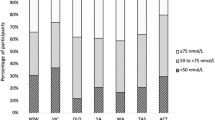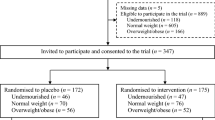Abstract
Objective: To determine the vitamin A and vitamin E statuses of socioeconomically disadvantaged preschool American children.
Design: Cross-sectional study of preschool children from socioeconomically disadvantaged families.
Setting: Central Iowa, USA.
Subjects: A group of 77 apparently healthy children was studied with the following characteristics: 5 mo–6 y; 37 males, 40 females; 56 non-Hispanic Caucasians, 3 Hispanics, 18 Afro-Americans.
Methods: Modified relative dose response (MRDR) test for vitamin A status assessment; serum retinol, α-tocopherol, cholesterol, and carotenoids; weight for age.
Results: Although the mean weight for age was the 53rd percentile of the NCHS standard, a significant number of children (P=0.006, Χ2) were either markedly underweight or overweight. Ratios of 3,4-didehydroretinol to retinol (DR/R) were >0.030 in 32% of the children. Mean serum retinol, α-tocopherol and cholesterol (±s.d.) were 1.09±0.23 μM/L, 16.8±6.3 μM/L and 4.01±0.8 mM/L. Three children (3.9%) showed a serum retinol value <0.7 μM/L. One child with a serum retinol value <0.7μM/L and one additional child showed a ratio of α-tocopherol to cholesterol <1.44 μmol/mmol. The mean α-tocopherol to cholesterol ratio for the group (4.31±1.71 μmol/mmol), however, was satisfactory. The only significant (P≤0.05) age-related changes were an increase in the serum cholesterol (P=0.005) and decrease in the α-tocopherol to cholesterol ratio (P<0.005) between the 0–2 y and the 2–4 y groups. Serum cholesterol (P=0.0165, two-tailed) and lycopene (P=0.004) concentrations of Afro-Americans were significantly higher than those of Caucasians. Median serum concentrations of α-carotene and β-carotene were lower and, of lycopene, higher than those found in children studied in a national survey. Serum carotenoid concentrations generally increased with age.
Conclusions: Larger percentages of underweight and overweight children and a significant degree (32%) of inadequate vitamin A status were found in this group of socioeconomically disadvantaged children. Afro-Americans showed higher serum cholesterol and lycopene concentrations than did Caucasians, but otherwise were nutritionally similar. Age-related changes were small. Of nutritional parameters considered, the vitamin A status of socioeconomically disadvantaged segments of our population clearly needs attention.
Sponsorship: NIH-HD27994, ISU/CDFIN/USDA 94-34115-0269
This is a preview of subscription content, access via your institution
Access options
Subscribe to this journal
Receive 12 print issues and online access
$259.00 per year
only $21.58 per issue
Buy this article
- Purchase on Springer Link
- Instant access to full article PDF
Prices may be subject to local taxes which are calculated during checkout
Similar content being viewed by others
Author information
Authors and Affiliations
Rights and permissions
About this article
Cite this article
Spannaus-Martin, D., Cook, L., Tanumihardjo, S. et al. Vitamin A and vitamin E statuses of preschool children of socioeconomically disadvantaged families living in the midwestern United States. Eur J Clin Nutr 51, 864–869 (1997). https://doi.org/10.1038/sj.ejcn.1600503
Received:
Revised:
Accepted:
Issue Date:
DOI: https://doi.org/10.1038/sj.ejcn.1600503
Keywords
This article is cited by
-
The positive impact of red palm oil in school meals on vitamin A status: study in Burkina Faso
Nutrition Journal (2006)



